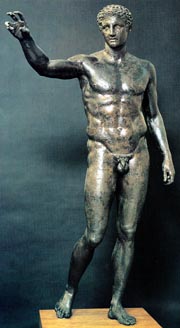The Fourth Century
c. 400-300 BCE
SCULPTURE

Antikythera Bronze
c. 350 BCE
Bronze
Height 6 feet 41/2 inches
(National Archaeological Museum of Athens)

Hermes and Dionysos
Praxiteles
c. 340 BCE
Marble
Height 7 feet 1 inch
(The Archaeological Museum at Olympia)
The leading Athenian sculptor of the Late Classical style was Praxiteles. An S shape, sometimes called the "Praxitelean curve," defines the stance of Hermes and Dionysos. It is thought that Hermes originally dangled a bunch of grapes toward which the infant reaches. When compared with Classical sculptures, the Hermes has slightly fleshier proportions and appears to have softer skin. Hermes's hair is more deeply carved, his forehead is creased, and his cheeks are fuller. Overall, his facial features are less distinct.

Aphrodite of Cnidos
Roman copy of an original by Praxiteles
c. 350 BCE
Marble
Height 6 feet 8 inch
(Vatican Museums, Rome)

Aphrodite and Eros
c. 350 BCE
Inner decoration of a folding mirror
Gilt bronze
from Tarquinia
Diameter 71/2 inches
(The Louvre, Paris)
On the outside of the mirror case (not shown), a relief of Aphrodite shows her clothed and seated next to Eros, who is drawing his bow. Inside the cover, an incised design shows Aphrodite standing in the nude holding the little figure of Eros close to her as he tries to shoot an arrow from his bow

 SPRING 2016
SPRING 2016  SCHEDULE
SCHEDULE  REQUIREMENTS
REQUIREMENTS

 SPRING 2016
SPRING 2016  SCHEDULE
SCHEDULE  REQUIREMENTS
REQUIREMENTS